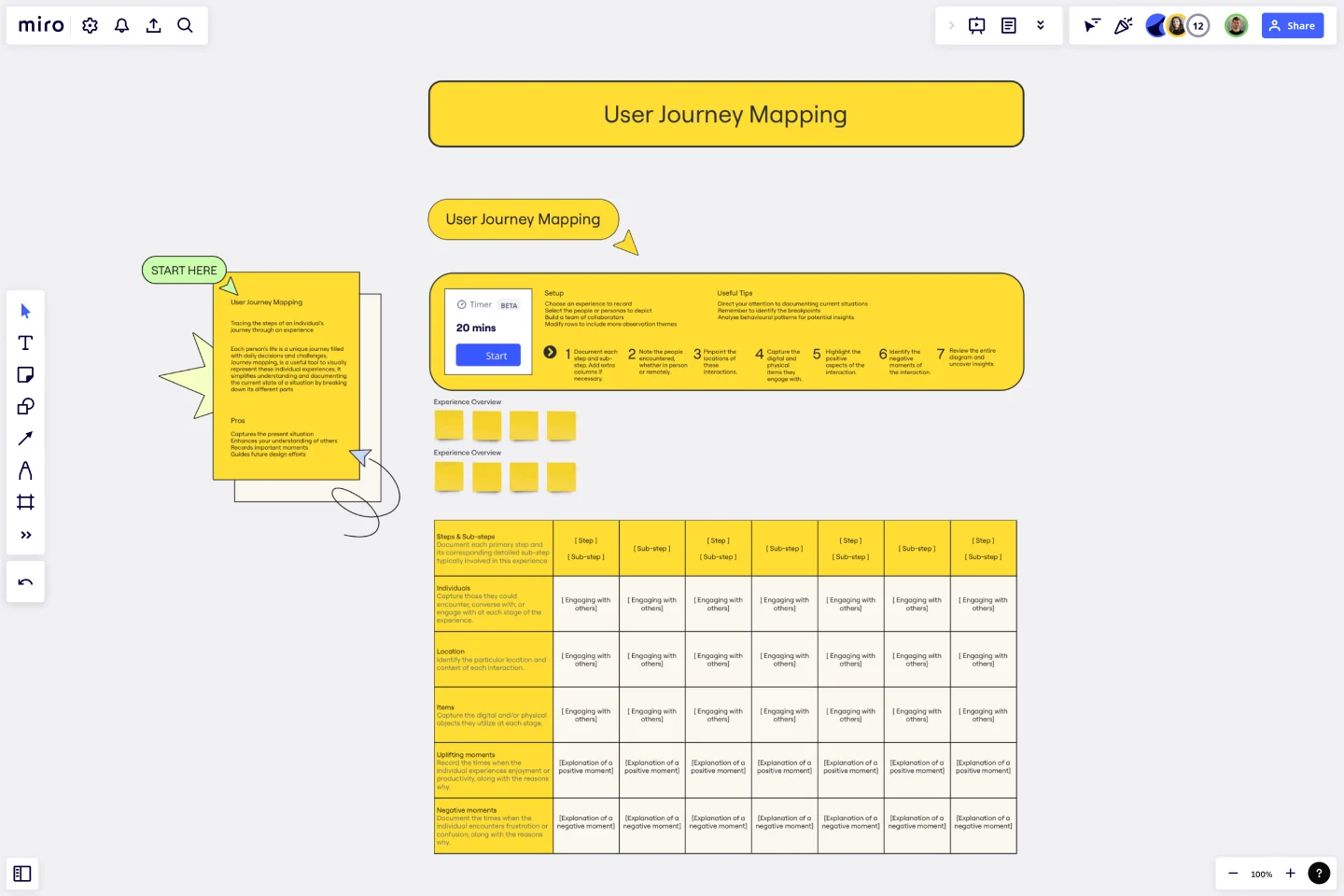User Journey Mapping Template
Trace the steps of an individual's journey through an experience with the User Journey Mapping Template.
About the User Journey Mapping Template
Journey mapping is a powerful tool that allows us to visually represent individual user experiences in a detailed and comprehensive manner. By breaking down the different parts of the user journey, we can better understand the challenges they face, the decisions they make, and the paths they take.
This process involves identifying the key milestones, events, and turning points that have shaped the journey and the people, places, and experiences that have had the most significant impact when using a product.
Benefits of using the template
Capture the present situation.
Enhance your understanding of others.
Record important moments.
Guide future design efforts.
How to use the template in Miro
Document each step and sub-step. Add extra columns if necessary.
Note the people encountered, whether in person or remotely.
Pinpoint the locations of these interactions.
Capture the digital and physical items they engage with.
Highlight the positive aspects of the interaction.
Identify the negative moments of the interaction.
Review the entire diagram and uncover insights.
Setup
Choose an experience to record.
Select the people or personas to depict.
Build a team of collaborators.
Modify rows to include more observation themes.
Useful tips
Direct your attention to documenting current situations.
Remember to identify the breakpoints.
Analyse behavioral patterns for potential insights.
Get started with this template right now.
Empathy Mapping for Impact
Works best for:
Market Research, Research & Design
Empathy Mapping For Impact template is designed to help you capture and understand user experiences deeply. By focusing on what users think, feel, and do, you can create impactful and meaningful products. Perfect for UX designers and researchers.
Analytics Storyboard
Works best for:
Planning, Storyboard, Design
Visualize your data insights with the Analytics Storyboard template. This tool is perfect for data analysts and business intelligence teams, helping you present complex data in a clear and engaging narrative format. It includes sections for data sources, key findings, and visualizations, ensuring your audience can easily understand and act on your insights. Use this template to create compelling data stories that drive informed decision-making and strategic planning.
Fiction Storyboard
Works best for:
Storyboard, Planning, Design
Unleash your creativity with the Fiction Storyboard template. Perfect for writers and storytellers, this template helps you map out your fictional narratives, including plot points, character arcs, and scene transitions. It provides a structured framework to visualize your story's progression and ensure consistency. Use it to organize your ideas, explore different storylines, and create a compelling narrative that captivates your audience from start to finish.
Empathy Map by Axelle Vanquaillie
Works best for:
Market Research, Research & Design
Empathy Mapping template is a valuable tool for gaining deep insights into user experiences. It helps you understand their motivations and challenges, ensuring your products address real needs. Ideal for UX researchers and designers.
Stakeholder Empathy Map by IASA
Works best for:
Market Research, Research & Design
Stakeholder Empathy Map Template is designed to understand the perspectives of stakeholders. It helps you capture their needs, concerns, and motivations, ensuring your projects align with stakeholder expectations and foster better collaboration.
UX Project Canvas Template
Works best for:
User Experience, UX Design, Market Research
Inspired by Alexander Osterwalder's 2005 business model canvas, the project canvas will help your team visualize the big picture of your UX and design projects, providing a convenient structure that holds all of your important data. This innovative tool enables you to transform an idea into a project plan, stimulating collaboration and communication between collaborators. Unlike alternative models, the project canvas is a simple interface. There are few startup costs, and employees can easily be brought up to speed to start using the canvas quickly.
